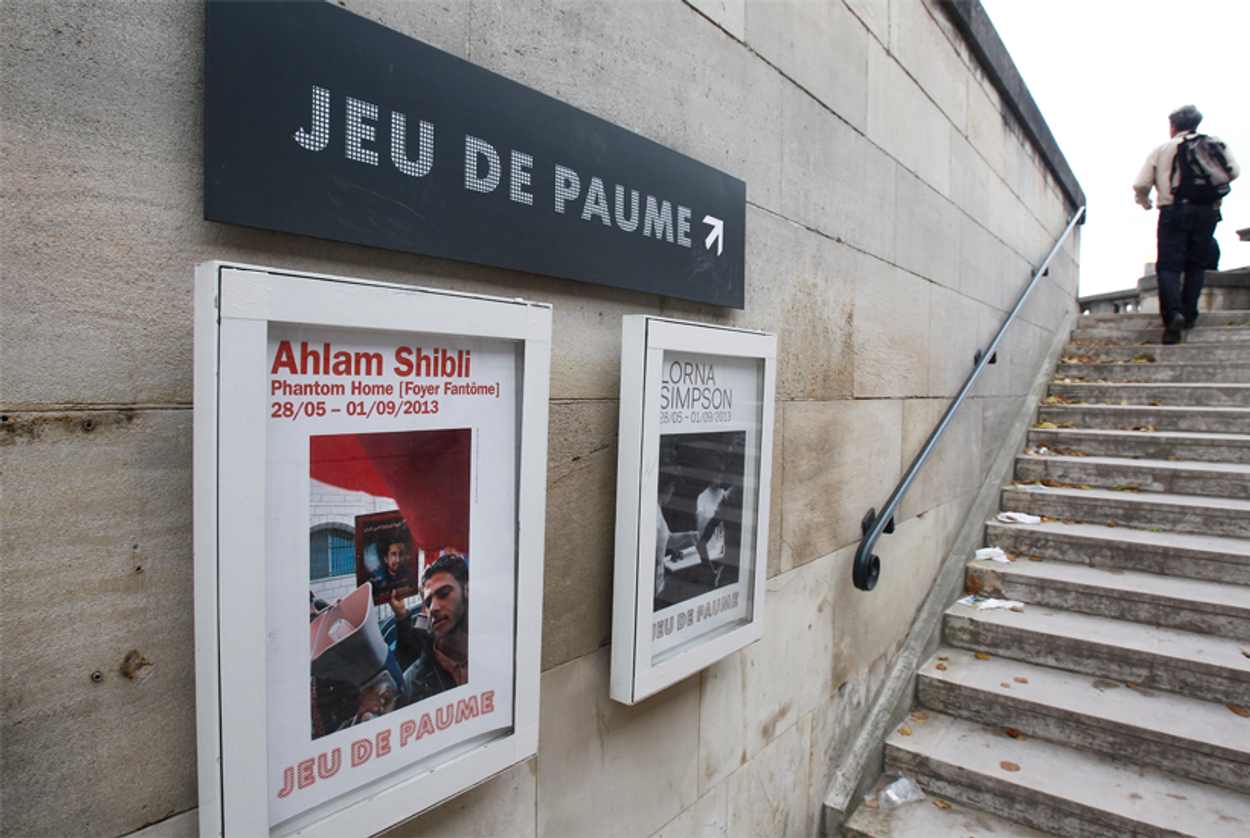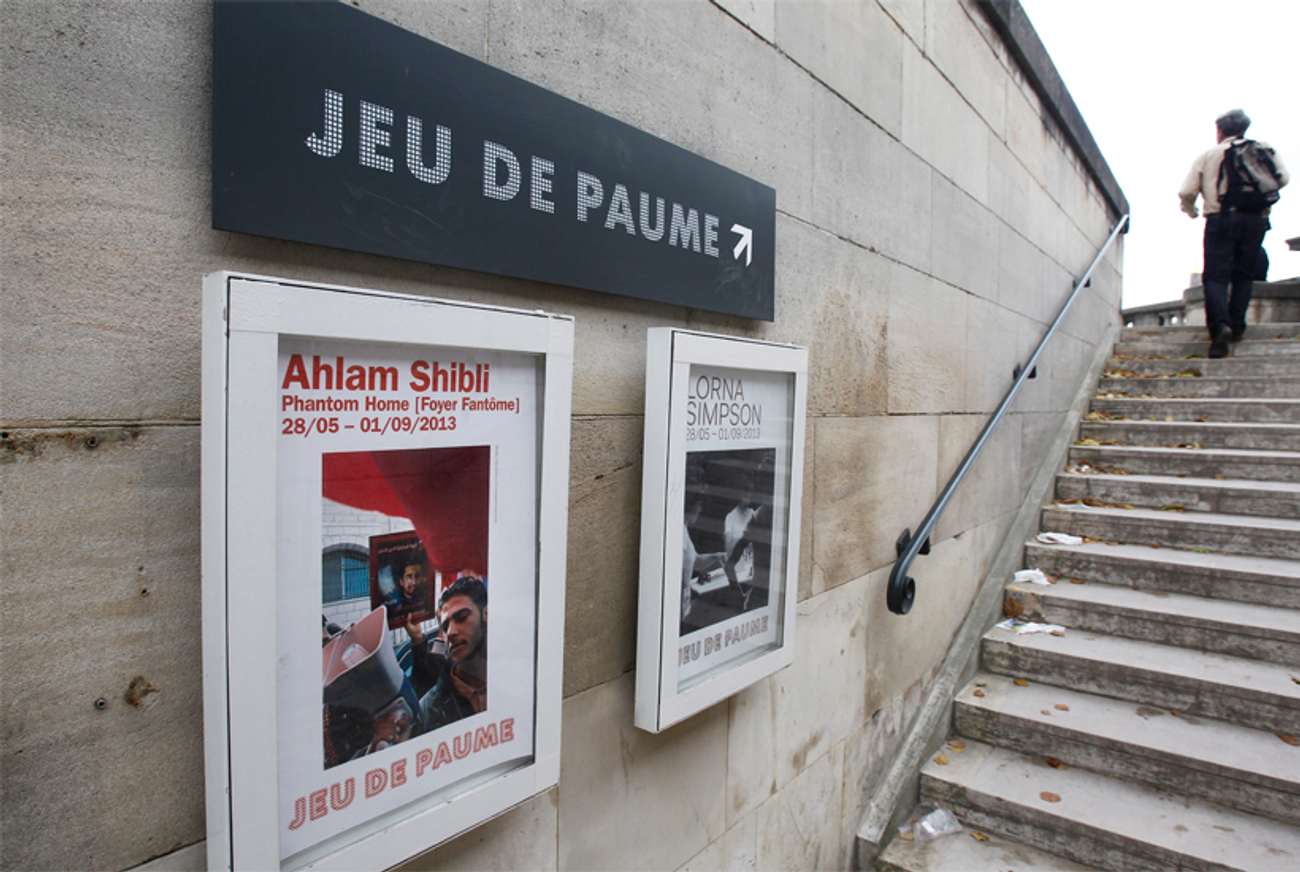Terrorist Chic in France, From the Jeu de Paume Exhibit to Al Durah to Muhammed Merah
A controversial new exhibit celebrates mass murderers and raises war propaganda to the level of high art




This Summer the French National Museum, the Jeu de Paume, once famous for its display of Impressionist paintings, is hosting an astonishing photography exhibit, Phantom House. The work of an Israeli Bedouin woman, Ahlam Shibli, it assembles an eclectic series of photographs that depict a number of different groups whose homes are really not theirs, or who do not have homes—people who “live under oppression.” These include Bedouin “Trackers” who enlist in the IDF, “Palestinians” living in the Galilee and Jordan, Polish children in orphanages, Middle Eastern LGBTs who live in Western countries, the French of Corrèze during the Nazi occupation, and, in by far the most elaborate of the exhibits, the Palestinian families of “martyrs” who “resisted” the “occupation,” standing with the pictures, posters, and graves of their “disappeared” relatives.
The exhibit has elicited predictable controversy. These alleged “martyrs” who “took control of their own deaths,” the object of loving devotion by their families, are actually mass murderers who killed themselves in order to murder as many children, women, civilians as they could. Like so much of the Palestinian narrative, these photos give no place to the “other” except as faceless colonial oppressors. For one Jewish woman, a patron of the museum, the experience was horrifying. Looking at these pictures of “martyrs,” she recognized people who had blown up restaurants and buses, which were chosen precisely because there were children there.
Outraged objections poured in. The museum’s response was to post a notice that insisted that this was not propaganda and quoted the artist insisting that she was “not a militant, not judgmental.”
Of course, all of this is nonsense. If not propaganda (like the famous pipe that is not a pipe), it is a display of lovingly presented photographs of propaganda. The artist is decidedly judgmental, presenting her fellow Bedouin who serve in the IDF as pathetic sell-outs to a colonial regime (they appear strikingly comfortable and secure with themselves in the photos), peppering her exhibit on French victims of the Nazi occupation with comments on how they turned around after liberation and became colonial oppressors in Indochina and Algeria. The unalloyed admiration for the “resistance to occupation” of the Palestinians, juxtaposed with that of the French resistance to the Nazis, plays on a common, if grotesque, theme of Palestinian propaganda—that the Israelis are the new Nazis and the Palestinians the new Jews.
How can the French, who know what Nazi occupation was like, compare their experience to that of Palestinians in the West Bank? How they could not notice that while the Nazis killed hundreds of thousands of civilians in occupied Europe as part of their deliberate policy of collective punishment, the Palestinians kill thousands of civilians as part of their “resistance”? How could they miss the difference between an “occupation” that kills 6 million Jews and one that produces a Palestinian population with the highest standard of living in the non-oil-rich Arab world? How can they glorify a movement that embraces and intensifies Nazi Jew-hatred? And why do they view Jews who attempt to protect themselves from that aggression through the eyes of those who foment hatred? How did such a profound moral disorientation occur, and why has it been elevated to the level of high art?
The answer takes us back to the beginning of the Second Intifada, known as the Al-Aqsa Intifada, on Sept. 30, 2000, when Charles Enderlin, the French-Israeli correspondent for France2 broadcast a news story on how the Israelis targeted a father and son, killing the son and badly wounding the father. The story rapidly gained mythical power in both the Muslim world and in the West. For some Palestinians, Al Durah became “the martyr of the world” and an inspiration to suicide bombers seeking to revenge his death; in the capable hands of Osama Bin Laden, he became a call to all Muslims to join the global Jihad.
In France and beyond, Europeans embraced this story as a liberation from Holocaust guilt. The respected French news anchor Catherine Nay spoke for many when she noted, “This death annuls, erases the picture of the boy in the Warsaw Ghetto.” In other words, the picture of one boy, caught in a cross-fire, replaces a picture that symbolizes the deliberate, cold-blooded murder of over a million children.
Under the aegis of this wildly popular image, which came to be known as an icon of hatred, the morally deranged (and sadistic) substitution theology of Palestinian war propaganda entered the European mainstream. From the first rally of French progressives and Muslims reacting to the Al Durah story—where at least one banner read “Star of David = Swastika = picture of the Al Durahs under fire” in 2000, and protesters cried, “Death to the Jews! Death to Israel!”—to the most recent ravings of the British Liberal Democrat Party, who compared Israel to the Nazis, the idea of Jews as Nazis became acceptable discourse among European elites.
Nothing better illustrates the danger involved in this moral derangement than the way this icon has operated in French society. Ironically, as French TV repeatedly showed this gratifying “get-out-of-Holocaust-guilt-free-card” to their French audiences, they waved the flag of Jihad in front of their restive Muslim youth. Not understanding that this Jihad targeted them as well, they assumed (for some strange reason), that those aroused to violent hatred of both Israelis and their cousins, French Jews, did not also consider them legitimate targets of Jihadi wrath. Thus as violence, both verbal and physical, against French Jews rose sharply, the French privately told Jews who complained that this is payback for Israeli deeds and publicly denied any anti-Semitism.
What might have been a brief disorientation, damaging but limited, has become a disastrous commitment to this new paradigm, even as the evidence for its deleterious effect on France (and, more broadly, Europe) multiplied. In 2004 and 2005, Spanish and English citizens found out that they, too, could be considered legitimate targets of Jihadi wrath. Several months later, in response to a false report that French police had killed two young French Arabs, the suburban “sensitive zones” erupted in rioting and vandalism, while the police stood aside lest intervention lead to photographs of police killing Arab youth and inspire suicide terror attacks.
Those French who, ignoring the plethora of minor subsequent incidents, might have thought their problems were more or less on a path toward resolution were shocked anew in 2012, when a young French-born Algerian Jihadi, Muhammed Merah, after killing three French Muslim soldiers, went to a Jewish school and deliberately killed three children and a father. Why? “To avenge those Muslims in Palestine murdered by the Israelis,” he said.
For the Jihadis, the war against Israel is part of a larger war against the West, and images of Israelis killing Palestinian children feed a war machine that targets all infidels who resist submission to Islam. And yet, few French tread this path of inquiry (although it might be said that their implacable hostility to Israel and its defenders betrays an unconscious knowledge of, and desire to appease, the anger that any support for Israel elicits from Jihadists). On the contrary, French commentators insisted, the riots in 2005, for example, had “nothing to do with Islam,” and the code word for Muslims who misbehave violently is “jeunes.”
Instead of awareness, a school of “lethal journalists” became dominant in Europe (and elsewhere)—information specialists who take Palestinian war propaganda (lethal narratives about the IDF as child-killers) and spread it to unsuspecting (and often gratified) audiences in the guise of news reporting. In 2002, for example, Europe’s lethal journalists told their audiences that the operation in Jenin to stop a two-year campaign of Palestinian suicide terror had massacred hundreds of innocent civilians—a claim that was later proven to be both false and deliberately manufactured for propagandistic purposes.
Rarely in the history of the modern press has a story with less substance had so much malevolent power.
Yet every time hostilities broke out over the course of the decade, European papers overflowed with images of Palestinian victims, with nary a mention of Palestinian hate propaganda inspiring suicide terror. And not surprisingly, these lethal journalists have done everything possible to protect the sanctity of their icon, Al Durah, the image choc de l’Intifada. The European press did not report on the evidence indicating that the original broadcast by Charles Enderlin was based on material that shows extensive signs—enumerated yet again in the recent Israeli-issued Kuperwasser Report—of having been staged for the cameras. Rarely in the history of the modern press has a story with less substance had so much malevolent power.
The French might have found out more, when Enderlin and France2’s recent attempt to use the courts to silence his critics for “defamation of character” backfired. The judges in one case, despite being on France2’s side, asked to see the “rushes” of the cameraman upon whom Enderlin relied for his devastating broadcast. They discovered that the majority of “action sequences” were staged. They accordingly found his critic, Philippe Karsenty, innocent, and had harsh words for Enderlin’s journalistic principles. But rather than analyze that story and present the evidence to the public, journalists formed a petition in support of Enderlin, warning that the verdict threatened “freedom of the press.” And many of the most prominent people who signed did so without seeing the evidence. A medieval guild of journalists, communautaristes to the hilt—fought for their personal freedom to pass along lethal narratives unimpeded by independent critics and, not coincidentally, preserved their tarnished icon of hatred.
Thus, cognitively disoriented by both their media and their academics to such a degree, it is altogether possible for the curators at the Jeu de Paume to put up an exhibit celebrating mass murderers—and to believe that, in so doing, they were siding with the innocent and “speaking truth” to Israeli “power.” And so they raise war propaganda that targets their own culture to the level of high art.
***
Like this article? Sign up for our Daily Digest to get Tablet Magazine’s new content in your inbox each morning.
Richard Landes, a historian living in Jerusalem, is chair of SPME’s Council of Scholars. He is the author of Heaven on Earth: The Varieties of the Millennial Experience and is currently writing They’re so Smart cause We’re so Stupid: A Medievalist Guide to the 21st Century. He blogs at the Augean Stables. His Twitter feed is @richard_landes.
Richard Landes, a historian living in Jerusalem, is chair of SPME’s Council of Scholars and a Senior Fellow at ISGAP. He is the author of Heaven on Earth: The Varieties of the Millennial Experience and Can “The Whole World” Be Wrong?: Lethal Journalism, Antisemitism and Global Jihad. He’s at Richard-Landes.com and on X @richard_landes.